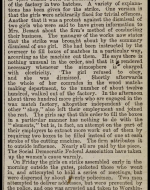Created by Geovanny Villanueva on Mon, 04/19/2021 - 16:50
Description:
Yesterday, Gerty and I were supposed to photograph a strike that happened at a match factory. Oh, the irony. Unfortunately, we weren’t able to photograph out there as there wasn’t much light out but I saved the newspaper article because it feels like a big moment. I’m glad to see women coming together for a common cause. I spoke to some of the women working in the factories and they said they were tired of being taken advantage of. I heard about how terrible the people who run the factory are. I’ve been told that many women working here have been getting sick but the factory owners don’t care. They aren’t even allowed to use the bathroom sometimes or else they get punished! The conditions that these women work under are terrible! I’m not sure who decided this was alright, but something has to be done and I stand with these ladies. I hope the strike sends a message to the factory owners that the workers are tired of being treated so poorly. The factory owners must surely realize that they need to change something and start improving the work conditions. I was thinking about how if we never started the shop, it is very possible we would be working in factories like these. I’m so fortunate to be working at the photography shop with my sisters where we don’t have to face such bad work conditions. I couldn’t imagine working such long days with no breaks. I hope for these women’s sake that the work conditions improve soon.
The newspaper article above details the “Match Girls’ Strike” that happened in 1888. Around 1400 women working at the Bryant & May match factory in London started a strike to protest the long work hours and work conditions. During this time, Britain had already gone through its industrial revolution. As it was still relatively new, there weren’t many regulations on labor, therefore the working conditions weren’t great. Many of these women were doing 14 hours of hard labor a day for low wages (Best). In order to save money, match companies were using white phosphorus over red phosphorous, such as what the Bryant & May match factory was doing. Because of the exposure to the more dangerous white sulfur, many of the women who worked in these match factories developed a condition known as “phossy jaw” where their jaw would rot due to the white phosphorous they were exposed to (“Matchgirls' Strike”). This disease would often spread to the brain and cause the women to have painful deaths. In 1906, white phosphorous in matchsticks finally became illegal. Part of the reason it took 18 years for the Bryant & May factory to switch to the harmless red phosphorous was that white phosphorous was much cheaper than red phosphorous (“Matchgirls' Strike”). While all the demands from the strike were achieved, it is unfortunate that many people had to lose their lives or suffer from phossy jaw several years after the strike for change to happen.
Best, Catherine. “Meet the Matchstick Women - the Hidden Victims of the Industrial Revolution.” The Conversation, 12 Jan. 2021, theconversation.com/meet-the-matchstick-women-the-hidden-victims-of-the-industrial-revolution-87453.
“Matchgirls' Strike.” Wikipedia, Wikimedia Foundation, 1 Apr. 2021, en.wikipedia.org/wiki/Matchgirls%27_strike.
“Newspaper Article Reporting the Match Girls' Strike.” The British Library, The British Library, 6 Feb. 2014, www.bl.uk/collection-items/newspaper-article-reporting-the-match-girls-s...


